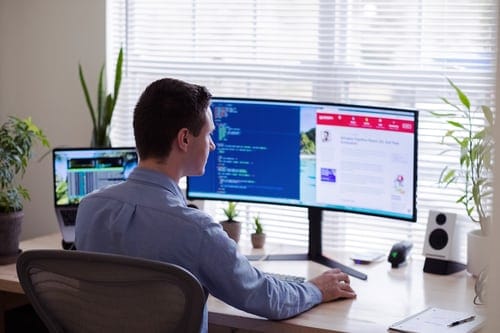Ergonomic and Home Office Setup Considerations for Working from Home

Working from home has become more ubiquitous, and so does the importance that should be placed on having a good ergonomic workstation at home. Having an ergonomically optimized workplace can help you work more efficiently and safely. Without bodily injury and recurring pain, you are able to better focus on tasks and become a more productive worker.
The goal of having an ergonomically optimized workspace is to help you maintain a neutral spine. A neutral spine stays in its natural curved “S” shape. Below are some guidelines for setting up your home office and workstation to be more ergonomic.
Desk Adjustments
Whether it be an actual office desk, dining room table, or folding table, the desk should fit your knees, feet, and thighs comfortably underneath. You should not have to press your legs together to fit. The knees should not bang up against anything.
Work Surface Adjustments
Your work surface and the items placed right on the surface (such as keyboard and mouse) should be at elbow height when you are seated. In a sitting position, your arms should be naturally and comfortably at your sides. If you feel that the work surface is too low, try using some books or a sturdy box to raise the work surface up. If the work surface is too high, adjust your chair up.
Chair Adjustments
If you work from home most days, consider getting an ergonomic office chair with lower back support. This should support your spine’s natural “S” shape. A kitchen stool or dining chair might cause back pain if seated for long periods of time, every day. If your chair does not have lower back support, try using a rolled up towel or small firm pillow as backrest.
When you sit in the chair, your feet should be flat on the floor. You should sit evenly on your bottom, without tilting to one side or the other. Your thighs should be parallel to the floor, and your knees at about hip height.
Monitor / Screen Placement
The monitor should be at or slightly below your eye level. Your eyes should look slightly down when looking at the middle of the screen. You should be able to hold your neck straight and easily see the top third of the screen. If your monitor height cannot be adjusted, use a riser or books to make it the right height. Adjust your chair if needed.
The monitor should be at least one arm’s length from you, so you are able to view the entire screen at once without having to turn your head from left to right.
You may also need to adjust the tilt on your screen. If you can see the screen just fine when it’s straight, leave it. However, you will likely need to angle the screen to reduce glare and achieve proper head positioning. The top will push away from you, and the bottom will come toward you. Most people tilt the screen back between 10 and 20 degrees. However, if you wear bifocal lenses, you may need to adjust the tilt by 30 to 40 degrees.
If you only have 1 monitor, place it in front of you. If you have 2 monitors, place them side by side without a gap. If you use one monitor more than the other, offset the less used monitor to the side. If you use 3 monitors, the main monitor should be in the middle, and the other two should be one each side of the main monitor with no gap and pointed slightly in.
If you use a laptop, the same ergonomic rules apply. The top of the laptop screen should be at or slightly below eye level. Prop the laptop up if it’s too low.
Keyboard Placement
The keyboard should be placed at elbow height. When you type, your wrists should remain straight, and your upper arms should stay close to your body. A flat keyboard is better since it helps you hold your wrists straight. You might want to consider getting a keyboard riser, or use rolled up small towel (or a large sock filled with rice) for extra comfort on the wrists as you type.
Mouse Placement
Your mouse should be near the keyboard and easy to reach without overextending any part of your body. A mouse riser, similar to keyboard riser, can help if you experience wrist pain. Some mouse pads have built-in risers made of foam or gel. Alternatively, you can use rolled up socks or small towel as a mouse riser.
Other Home Office Setup Considerations
Bright light that shines directly on the monitor screen can cause harsh glare that is hard on the eyes. Position yourself and the equipment perpendicular to a window, or adjust the window blinds to help reduce any glare.
To reduce eye fatigue, take breaks away from the screen by following the 20/20/20 guideline (every 20 minutes, take your eyes off the screen for 20 seconds, focus on something 20 feet away). Having green plants in and around the workspace does not only liven up the mood, but it can also help with reducing eye strain. Studies have shown that looking at something green every once in a while can help freshen up eyesight and reduce eye fatigue.
Don’t forget to move and stand up from your chair at least every hour. Take a quick refresh exercise such as stretching your shoulders and wrists, standing up out of your chair and reaching upwards to unload the back discs, and doing ankle rotation to encourage lower body circulation.